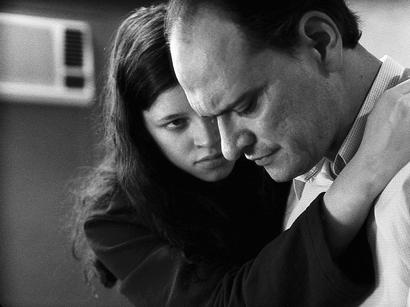Lucrecia Martel’s new film about suspense and paradox, a gem of Argentina’s New Wave
Widescreen looked bigger in the ‘50s, when directors made cinema luxurious in order to compete with television’s convenience. Over the past few decades, even Cinemascope films have been tamed by the demand that they remain legible on a home monitor. Few recent ’Scope films consistently use every inch of the frame: Wes Anderson’s work is an exception.
Initially, acquired by HBO, “The Holy Girl” will probably look pretty good on TV, given its extensive use of tight close-ups and avoidance of long shots. Its dimensions are smaller than Cinemascope—it’s meant to be shown on a screen 1.85 times as wide as it is tall. Nevertheless, it would be a travesty to show it on TV without letterboxing.
Ironically, director Lucrecia Martel’s style may have been influenced by watching actors’ heads and bodies get chopped up in cropped versions of widescreen films. She’s taken this look to an extreme, creating a world that’s constantly spilling over the frame’s edges. In this respect, she’s an Argentine descendant of Jean Renoir.
In “The Holy Girl,” the screen seems cramped, claustrophobic, almost inadequate to convey all its information. Its space is off-kilter, almost disorienting. However, Martel knows exactly what she’s doing—creating an aesthetic that requires an active spectator to take the offscreen world into account, especially because she uses sound design as counterpoint. Few films are directed with this much assurance.
Sixteen-year-old Amalia (Maria Alché) lives in a run-down hotel operated by her mother Helena (Mercedes Moran) and uncle Freddy (Alejandro Urdapilleta). Extremely religious, the girl has many intense conversations with her best friend Josefina (Julieta Zylberberg). Inspired by discussions about faith, she becomes convinced that she’s destined to hear the call of God. In the meantime, a medical convention convenes at the hotel. These two worlds collide on the street outside a music store.
Watching a man playing an electronic instrument called a theremin, Dr. Jano (Carlos Belloso) grinds his crotch against Amalia’s ass, in a scene that balances her puzzled expression, the eerie music and traffic noises. She keeps this event secret from her mother, who’s attracted to Dr. Jano, but tells Josefina that she’s found her life’s mission. She must save the doctor from further sin.
“The Holy Girl” treats Catholicism with skepticism, linking spiritual urges to carnal ones, but it never makes Amalia’s faith look ridiculous. It also avoids demonizing Dr. Jano, who seems like a decent man when sex is out of the picture. (Apparently, medical conventions are lustful hothouses.)
The film resists easy interpretations of Amalia’s behavior, like jumping to the conclusion that she’s using religion to rationalize Dr. Jano’s molestation. The film gets physically intimate with its characters—it is filled with shots of them lying down, captured from a very short distance—yet at the same time feels emotionally reticent.
Eventually, the film’s warmth comes closer to the surface. The narrative progresses more through blocking and framing than big dramatic moments. Theatrical role-playing plays a large role in the story. The film builds to a level of near-Hitchcockian suspense, crosscutting between several groups of characters. Yet it somehow resists melodrama, ending on a note that simultaneously evokes both isolation and community, paradoxically filled with pounding urgency and a great serenity. These feelings aren’t contradictory; they represent Amalia’s complex emotional state, and the film produces them with great subtlety.
Argentina’s financial crisis has coincided with a filmmaking boom. Unlike many such movements, this film phenomenon didn’t take long to come to the rest of the world’s attention. Martel’s much weaker first film, “La Cienaga,” played the 2001 New York Film Festival and was released in the U.S. At first, Argentina’s new young directors seemed to produce nothing but moderately likable trifles (Diego Lerman’s “Suddenly”) and overrated mediocrities (Pablo Trapero’s “El Bonarense” and “Rolling Family,” Lisandro Alonso’s “La Libertad.”)
With “The Holy Girl,” this Argentine New Wave has finally produced a great film.
gaycitynews.com



































